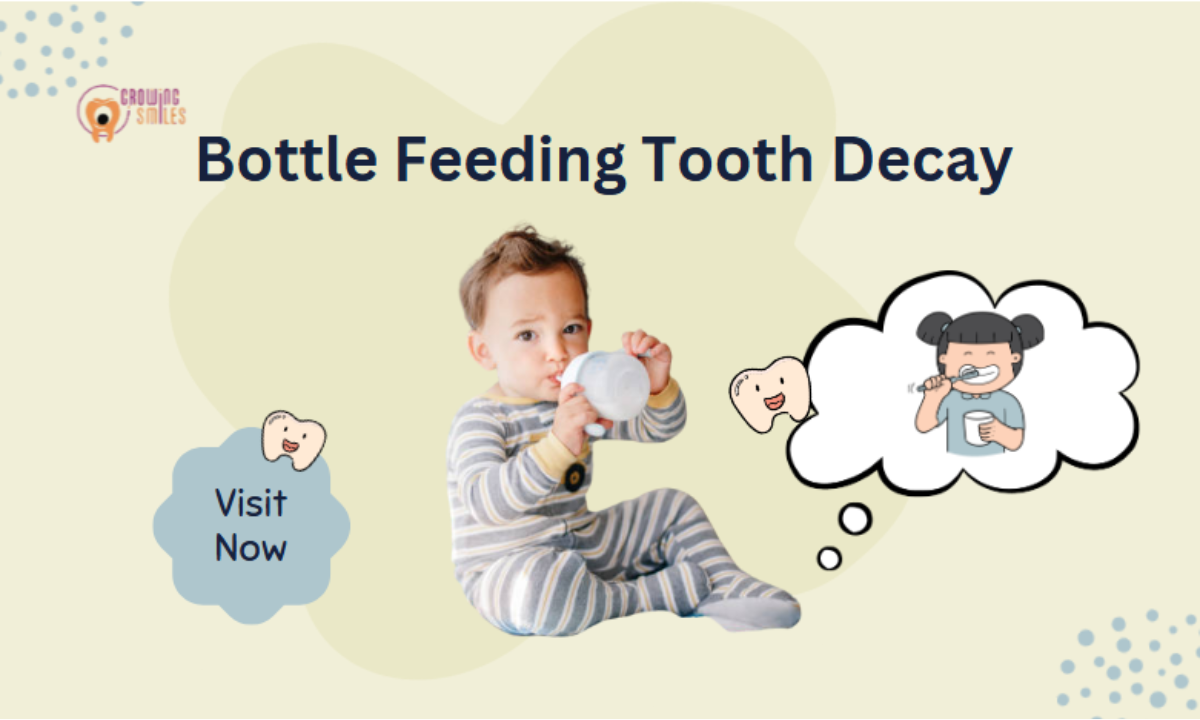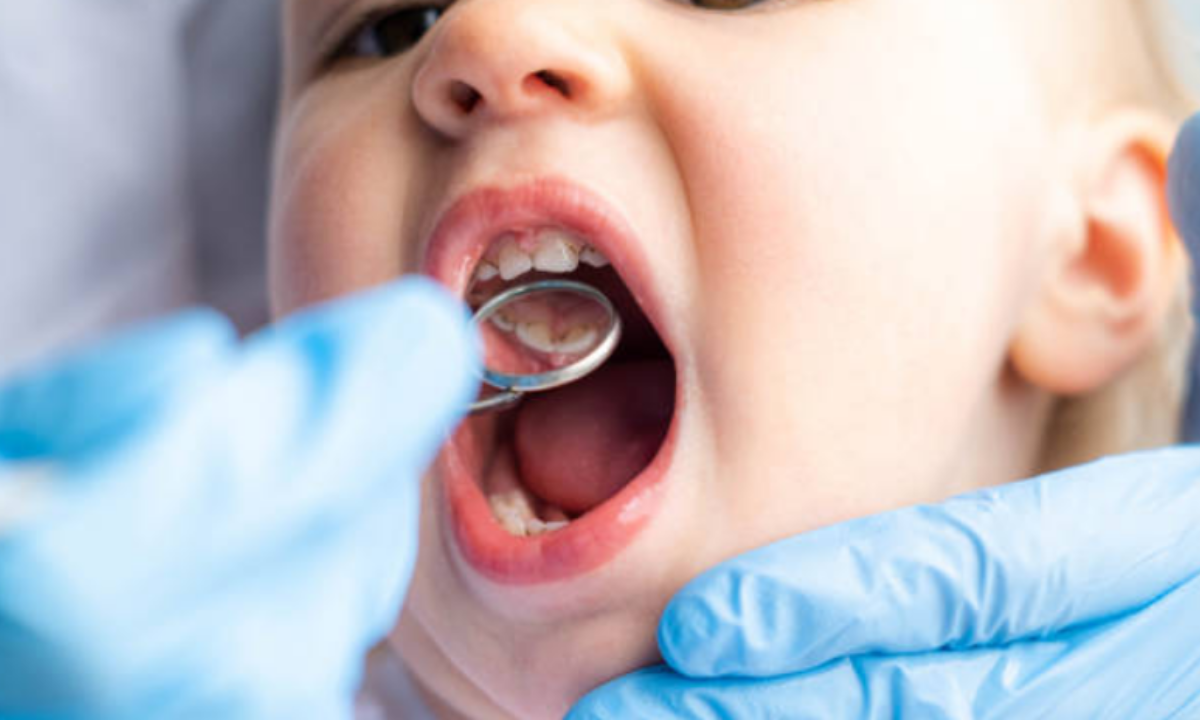From the moment your baby’s first tooth appears, you may start hearing about “tooth decay” and “milk tooth decay treatment.” But what exactly is bottle feeding tooth decay, and how can parents prevent it?
In this article, we will walk through the meaning, early signs, stages, causes, prevention strategies, and treatment options. We will also look at how choosing the right pediatric dentists matters, especially in the Whitefield area of Bangalore.
What Is Bottle Feeding Tooth Decay?
“Bottle feeding tooth decay” is a form of dental decay in infants and toddlers often referred to by dentists as early childhood caries (ECC). It’s also sometimes called “nursing bottle caries” or “baby bottle tooth decay.” These terms reflect their common origin, when a baby’s teeth are repeatedly exposed to sugary liquids (milk, formula, juice) from a bottle over time.
In simpler terms, tooth decay meaning in this context is the degradation of tooth enamel and structure in primary (baby) teeth due to acid produced by bacteria feeding on sugars. Even though these are milk teeth, preserving them is critical to support proper chewing, speech, and space maintenance for permanent teeth.
Early Signs & Stages of Tooth Decay
To catch problems early, it helps to know what the tooth decay early stages look like:
- White Spots or Lines: The first sign may be chalky white areas near the gumline on front teeth.
- Brown Spots / Pitting: As decay progresses, you might see brown discoloration or small pits.
- Cavitation / Holes: Further progression leads to visible cavities, weakening of the tooth structure.
- Pain / Sensitivity: In advanced stages, the child may complain of a toothache or discomfort, especially during feeding or eating.
In terms of tooth decay stages, one widely used classification in dentistry looks at lesions from initial demineralization through enamel and dentin breakdown, to pulpal involvement.
The key is that in early stages, damage may be reversible with fluoride and good hygiene; once a cavity forms, restorative treatment is needed.
How Bottle Feeding Causes Tooth Decay
Why is using a bottle risky? Several interlinked causes contribute to bottle feeding tooth decay:
- Prolonged exposure to sugars: Even natural sugars in milk or formula feed oral bacteria, producing acid that erodes enamel. Babies falling asleep with a bottle keep their teeth bathed in sugar for hours.
- Frequent feeding or sipping: Constant use of bottles (beyond mealtimes) lengthens exposure time.
- Bottle propping: Allowing the child to hold or prop the bottle so liquid pools in the mouth increases decay risk.
- Bacterial transmission: Caregivers may inadvertently pass cavity-causing bacteria (e.g. Streptococcus mutans) through shared spoons, cleaning pacifiers in their mouths, etc.
- Low fluoride exposure/enamel weakness: If enamel is weak or not protected by fluoride, decay accelerates.
Research even shows a significant association between bottle feeding and higher instances of ECC.
How to Avoid Decay of Tooth: Preventive Strategies
Preventing tooth decay beginning is far better (and simpler) than dealing with advanced damage. Here are effective ways to avoid decay of teeth in infants and toddlers:
- Avoid bedtime bottles: Never let your child go to sleep with a bottle containing anything but water. This reduces prolonged sugar exposure.
- Wean off the bottle: Transition to a cup or sippy cup by around age 12 months. Gradually phase out the bottle.
- Brush early: When the first tooth appears, brush gently with a soft, child-sized toothbrush and a smear (rice-sized) of fluoride toothpaste.
- Wipe gums / clean mouth: Even before teeth erupt, clean gums with a soft cloth after feeding.
- Limit sugary drinks/snacks: Avoid using bottles for sweetened fluids, juice, or sugar water.
- Do not share utensils or pacifiers by mouth: This reduces transfer of decay-causing bacteria.
- Regular dental visits: The American Academy of Pediatric Dentistry recommends that children see a dentist by age 1.
- Fluoride & sealants: Dentists may recommend fluoride varnish or application, depending on the child’s risk.
With consistent habits, many instances of early decay can be reversed or held in check before they worsen.
Treatment & Solutions for Milk Tooth Decay
When decay advances, milk tooth decay treatment becomes necessary. Options depend on severity:
- Fluoride varnish / topical fluoride: For very early lesions, fluoride can help remineralize enamel.
- Fillings/restorations: For cavitated lesions, the decayed portion is removed, and the tooth is filled with biocompatible materials.
- Crowns (Stainless Steel / Zirconia): If decay is extensive, pediatric dentists may place full-coronal crowns to protect the remaining tooth.
- Pulp therapy: If decay reaches the pulp (nerve), treatments like pulpotomy or pulpectomy may be needed.
- Extraction: In cases where the tooth is beyond repair or poses a risk of infection, removal may be safest.
- Behavioral interventions & preventive reinforcement: Post-treatment, the dentist will guide parents on better habits, hygiene, diet, and monitoring.
Prompt treatment helps relieve tooth decay pain, stop further damage, and protect the health and development of future permanent teeth.
Why Early Attention Matters
Ignoring tooth decay treatment in baby teeth can lead to:
- Persistent pain and infection
- Difficulty eating or speaking
- Premature loss of baby teeth can cause misalignment of permanent teeth
- Higher risk of decay in permanent teeth
- Poorer oral health habits later
Because baby teeth act as placeholders for adult teeth, preserving them is critical.
Choosing the Right Pediatric Dentists in Whitefield
When your child shows signs of tooth decay, you will want a trusted pediatric specialist. In Whitefield, Bangalore, there are several reputable names:
Growing Smiles Dental Clinic is among the well-known pediatric dentists in Whitefield, offering child-centric care, modern equipment, and a warm environment.
Many parents also explore other best dental clinics in Whitefield for their child’s oral care, but Growing Smiles stands out for specialization and reputation.
When choosing, look for:
- Credentials in pediatric dentistry / preventive dentistry
- Child-friendly clinic ambience
- Experience in managing dental anxiety/behavior techniques
- Preventive services (fluoride, sealants)
- Proximity to your location for ease of follow-ups
Conclusion
Bottle feeding tooth decay is a preventable condition, but one that can seriously affect a child’s oral health if ignored. Recognizing early signs, understanding tooth decay stages, and creating safe feeding and hygiene practices can make a big difference.
When treatment is needed, prompt, child-sensitive care by qualified pediatric dentists in Whitefield ensures healthier outcomes. Suppose you are in the Whitefield area and seeking expert care. In that case, Growing Smiles Dental Clinic is a trusted choice to support your child’s dental health journey with compassion, expertise, and a kid-friendly environment.
Frequently Asked Questions (FAQs)
Q: What is the difference between bottle feeding and tooth decay and regular tooth decay?
Bottle feeding tooth decay refers specifically to decay caused by prolonged exposure to sugary liquids from bottles in infants or toddlers, often starting early on primary teeth. Regular tooth decay can affect older children and adults and is influenced by diet, hygiene, bacteria, and fluoride exposure.
Q: When does bottle feeding tooth decay typically begin?
It often begins soon after baby teeth emerge, especially the front upper teeth, when there is frequent exposure to sugary liquids. The process is linked to continuous acid attacks from bacteria feeding on sugars.
Q: Does milk cause tooth decay?
Yes, milk (and formula) contains natural sugars (lactose). If left on teeth for long periods, especially during sleep, the sugar can fuel acid-producing bacteria, contributing to decay.
Q: How painful is early tooth decay in babies?
Early decay may not cause noticeable pain. As it worsens into deeper cavities or pulp involvement, children may feel sensitivity, pain during feeding or chewing, or may avoid certain foods.
Q: Can early decay be reversed without drilling?
Yes, if caught very early (white-spot lesions), remineralization with fluoride, diet control, and improved oral hygiene can stop or reverse damage. Drilling is only needed once cavitation occurs.
Q: At what age should a child first see a dentist to prevent bottle feeding tooth decay?
Most pediatric dental bodies recommend the first dental visit by age 1 or within six months after the first tooth erupts, to allow early guidance and preventive care.


